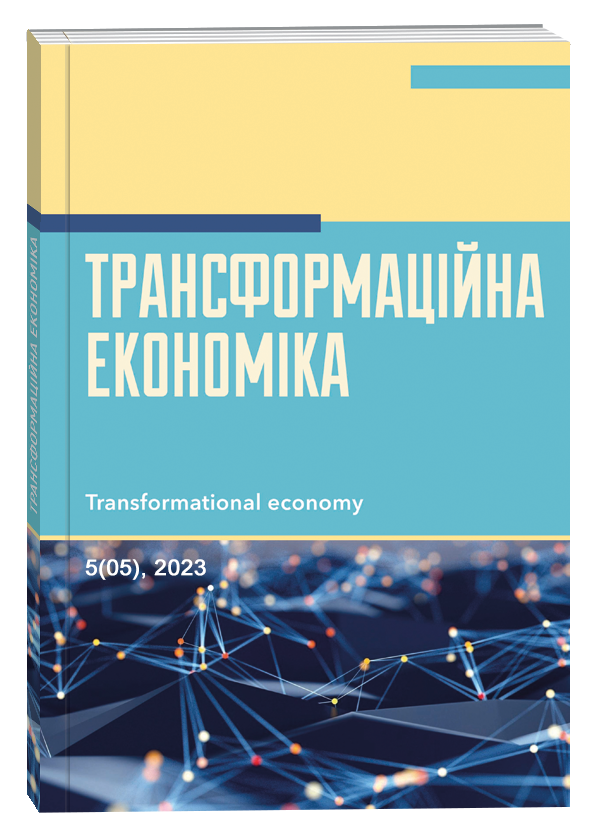ANALYSIS OF PROBLEMS OF ECONOMIC STABILITY OF ENTERPRISES WITH WEAK DYNAMICS IN THE CRISIS PERIOD
Abstract
This article presents a series of studies that allow us to draw a number of conclusions regarding the measurable indicator of enterprise sluggishness. The sluggishness of an enterprise as a whole is characterized by the sluggishness indicators of individual productions that it implements within the framework of its activities. In this case, the analysis of individual types of production activities allows not only to ultimately form an integral indicator of enterprise sluggishness, but also to rank types of production activities by the degree of their sluggishness. This opens up opportunities for developing a set of measures to reduce sluggishness at the enterprise level by organizing production processes within the enterprise in such a way that the integral indicator of enterprise sluggishness would have a minimal value. Evaluation of integral indicators of enterprise sluggishness allows us to predict the degree of vulnerability of enterprises with weak dynamics during a crisis period, provided that information on the main parameters of the crisis is available. For this purpose, we apply the apparatus of fuzzy logic, which allows us to obtain the result of assessing the crisis resistance of enterprises in the form of a fuzzy set. In this case, the assessment of the integral indicator of sluggishness can be carried out only taking into account the real factors influencing sluggishness, and then – with additional consideration of potential factors reducing sluggishness, which will gain weight when implementing a set of measures to reduce sluggishness at the enterprise level. Formation of a ranked list of enterprises with weak dynamics in the form of a fuzzy linguistic variable allows us to further construct a mathematical model for assessing the crisis resistance of enterprises using the apparatus of fuzzy logic, excluding a separate consideration of the stochasticity of the problem being solved and an assessment of the accuracy of calculating the integral indicator of sluggishness and the main parameters of the crisis. In this case, it is more correct to consider enterprises within the framework of their classification by the level of specialization, dividing the ranked list of enterprises into three categories. Since specialized enterprises, due to the limited types of production activities, will face more serious difficulties in developing a set of measures to reduce sluggishness. The range of possible instruments in the case of specialized enterprises is very limited, so they often resort to direct subsidized support for such enterprises.
References
Sosnovska O.O., Dedenko L.V. (2018), Napryami stiykogo funktsionuvannya pidpriemstva v umovah neviznachenosti [Trands of sustainable functioning of the enterprise in conditions of uniqueity]. Zbirnik naukovih prats Universitetu Derzhavnoyi fiskalnoyi sluzhbi Ukrayini, no 2, pp. 369–383. (in Ukrainian)
Lagunova I.A. (2018), Sutnist ta printsipi kontseptsiyi rizik-menedzhmentu. [Essence and principles of risk management concept]. Aktualni problemi derzhavnogo upravlinnya, no 1 (53), pp. 44–52. (in Ukrainian)
Dyadyuk M.A. (2017), Upravlinnya rizikami: konsp. lekts. [Risk Management: cons. lectures]. Harkiv: Fort. [Online], p. 165. Available at: http://elib.hduht.edu.ua/jspui/handle/123456789/1893 (accessed: 15.04.2022).
Posohov I.M. (2017), Suchasni mizhnarodni standarti rizik-menedzhmentu [Modern international standards of risk management]. Suchasni tendentsiyi rozvitku svitovoyi ekonomiki: zb. materialIv 9-yi Mizhnar. nauk.-prakt. konf., Harkiv : HNADU, Tom. 2, pp. 77–78. (in Ukrainian)
Gonchar G.P. (2014), Adaptatsiya svitovih standartiv rizik-menedzhmentu do diyalnosti vitchiznyanih kompaniy [Adaptation world standards of risk management to the activities of domestic companies]. Efektivna ekonomika, no 3. (in Ukrainian)
DudnEva Yu.E. (2019), Rizik-menedzhment: Integrovaniy pidhid do organizatsiyi [Risk management: an integrated approach to an organization]. Ekonomika ta suspilstvo, no 20, pp. 229–236. (in Ukrainian)
Moroz, I.O. (2017), Sutnіst upravlinnya rizikami pidpriemstva ta navichki, neobhidni menedzheru dlya yogo provadzhennya [The essence of risk management of the enterprise and nurses, the necessary manager for its processing]. Zbirnik materialiv Vseukrayinskoyi naukovo-praktichnoyi on-line konferentsiyi aspirantiv, molodih uchenih ta studentiv ZHDTU. [Online], Tom 2. Available at: https://conf.ztu.edu.ua/wp-content/uploads/2017/06/115-1.pdf
Volinets I. (2016), Organizatsiya rizik-menedzhmentu na pidpriemstvi [The Оrganization of Risk Management at the Enterprise]. Ekonomichniy chasopis Shidnoevropeyskogo natsionalnogo universitetu imeni Lesi Ukrayinki, no 2, pp. 51–55. (in Ukrainian)
Сосновська О.О., Деденко Л.В. Напрями стійкого функціонування підприємства в умовах невизначеності. Збірник наукових праць Університету Державної фіскальної служби України. 2018. № 2. С. 369–383.
Лагунова І.А. Сутність та принципи концепції ризик-менеджменту. Актуальні проблеми державного управління. 2018. № 1 (53). С. 44–52.
Дядюк М. А. Управління ризиками: консп. лекц. Харків : Форт, 2017. C. 165. URL: http://elib.hduht.edu.ua/jspui/handle/123456789/1893
Посохов І.М. Сучасні міжнародні стандарти ризик-менеджменту // Сучасні тенденції розвитку світової економіки: зб. матеріалів 9-ї Міжнар. наук.-практ. конф., Харків : ХНАДУ, 2017. Т. 2. С. 77–78.
Гончар Г.П. Адаптація світових стандартів ризик-менеджменту до діяльності вітчизняних компаній. Ефективна економіка. 2014. № 3.
Дуднєва Ю.Е. Ризик-менеджмент: інтегрований підхід до організації. Економіка та суспільство. 2019. № 20. С. 229–236.
Мороз І.О. Сутність управління ризиками підприємства та навички, необхідні менеджеру для його провадження Збірник матеріалів Всеукраїнської науково-практичної on-line конференції аспірантів, молодих учених та студентів ЖДТУ. 2017. Т. 2. URL: https://conf.ztu.edu.ua/wp-content/uploads/2017/06/115-1.pdf
Волинець І. Організація ризик-менеджменту на підприємстві. Економічний часопис Східноєвропейського національного університету імені Лесі Українки. 2016. № 2. С. 51–55.


